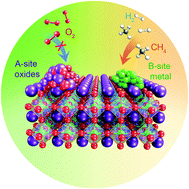当前位置:
X-MOL 学术
›
Chem. Soc. Rev.
›
论文详情
Our official English website, www.x-mol.net, welcomes your
feedback! (Note: you will need to create a separate account there.)
Controlling cation segregation in perovskite-based electrodes for high electro-catalytic activity and durability
Chemical Society Reviews ( IF 40.4 ) Pub Date : 2017-09-18 00:00:00 , DOI: 10.1039/c7cs00120g Yifeng Li 1, 2, 3, 4 , Wenqiang Zhang 1, 2, 3, 4 , Yun Zheng 1, 2, 3, 4 , Jing Chen 1, 2, 3, 4 , Bo Yu 1, 2, 3, 4 , Yan Chen 5, 6, 7, 8, 9 , Meilin Liu 10, 11, 12, 13
Chemical Society Reviews ( IF 40.4 ) Pub Date : 2017-09-18 00:00:00 , DOI: 10.1039/c7cs00120g Yifeng Li 1, 2, 3, 4 , Wenqiang Zhang 1, 2, 3, 4 , Yun Zheng 1, 2, 3, 4 , Jing Chen 1, 2, 3, 4 , Bo Yu 1, 2, 3, 4 , Yan Chen 5, 6, 7, 8, 9 , Meilin Liu 10, 11, 12, 13
Affiliation

|
Solid oxide cell (SOC) based energy conversion systems have the potential to become the cleanest and most efficient systems for reversible conversion between electricity and chemical fuels due to their high efficiency, low emission, and excellent fuel flexibility. Broad implementation of this technology is however hindered by the lack of high-performance electrode materials. While many perovskite-based materials have shown remarkable promise as electrodes for SOCs, cation enrichment or segregation near the surface or interfaces is often observed, which greatly impacts not only electrode kinetics but also their durability and operational lifespan. Since the chemical and structural variations associated with surface enrichment or segregation are typically confined to the nanoscale, advanced experimental and computational tools are required to probe the detailed composition, structure, and nanostructure of these near-surface regions in real time with high spatial and temporal resolutions. In this review article, an overview of the recent progress made in this area is presented, highlighting the thermodynamic driving forces, kinetics, and various configurations of surface enrichment and segregation in several widely studied perovskite-based material systems. A profound understanding of the correlation between the surface nanostructure and the electro-catalytic activity and stability of the electrodes is then emphasized, which is vital to achieving the rational design of more efficient SOC electrode materials with excellent durability. Furthermore, the methodology and mechanistic understanding of the surface processes are applicable to other materials systems in a wide range of applications, including thermo-chemical photo-assisted splitting of H2O/CO2 and metal–air batteries.
中文翻译:

控制钙钛矿基电极中的阳离子偏析,以实现高电催化活性和耐久性
基于固体氧化物电池(SOC)的能量转换系统具有高效,低排放和出色的燃料灵活性,因此有可能成为用于电力和化学燃料之间可逆转换的最清洁,最高效的系统。然而,由于缺乏高性能电极材料,阻碍了该技术的广泛实施。虽然许多基于钙钛矿的材料已显示出作为SOC电极的显着前景,但经常观察到表面或界面附近的阳离子富集或离析,这不仅极大地影响了电极动力学,而且极大地影响了电极的耐用性和使用寿命。由于与表面富集或偏析相关的化学和结构变化通常仅限于纳米级,需要先进的实验和计算工具来以高时空分辨率实时探测这些近表面区域的详细组成,结构和纳米结构。在这篇综述文章中,概述了该领域的最新进展,重点介绍了几种基于钙钛矿的材料系统中的热力学驱动力,动力学以及表面富集和偏析的各种构型。然后强调对表面纳米结构与电极的电催化活性和稳定性之间的相关性的深刻理解,这对于实现合理设计具有优异耐久性的更高效SOC电极材料至关重要。此外,2个O / CO 2和金属空气电池。
更新日期:2017-09-18
中文翻译:

控制钙钛矿基电极中的阳离子偏析,以实现高电催化活性和耐久性
基于固体氧化物电池(SOC)的能量转换系统具有高效,低排放和出色的燃料灵活性,因此有可能成为用于电力和化学燃料之间可逆转换的最清洁,最高效的系统。然而,由于缺乏高性能电极材料,阻碍了该技术的广泛实施。虽然许多基于钙钛矿的材料已显示出作为SOC电极的显着前景,但经常观察到表面或界面附近的阳离子富集或离析,这不仅极大地影响了电极动力学,而且极大地影响了电极的耐用性和使用寿命。由于与表面富集或偏析相关的化学和结构变化通常仅限于纳米级,需要先进的实验和计算工具来以高时空分辨率实时探测这些近表面区域的详细组成,结构和纳米结构。在这篇综述文章中,概述了该领域的最新进展,重点介绍了几种基于钙钛矿的材料系统中的热力学驱动力,动力学以及表面富集和偏析的各种构型。然后强调对表面纳米结构与电极的电催化活性和稳定性之间的相关性的深刻理解,这对于实现合理设计具有优异耐久性的更高效SOC电极材料至关重要。此外,2个O / CO 2和金属空气电池。











































 京公网安备 11010802027423号
京公网安备 11010802027423号